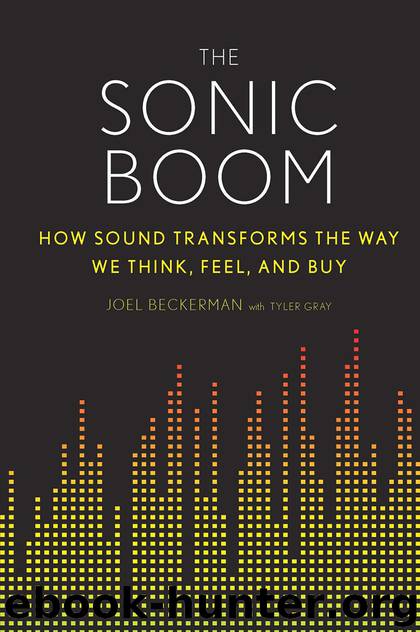The Sonic Boom by Joel Beckerman

Author:Joel Beckerman
Language: eng
Format: epub
Publisher: Houghton Mifflin Harcourt
Before we could translate anything into the language of sound, we all had to speak AT&T. The company values inventiveness and is always endeavoring to come up with unique ways to connect people who want to communicate. Anyone who’s ever heard the soundtrack to American Beauty or A Beautiful Mind or the syncopated piano riff from Coldplay’s “Clocks” has the sound of inventive. It’s plucky, fresh.
AT&T is also purposeful. Its pursuit of innovation isn’t whimsical. It’s relentless. And people look to AT&T’s technology to get things done. From a musical standpoint, purposeful has a certain propulsion to it. It sounds like the Penguin Café Orchestra or Philip Glass.
Curious describes the quirk in AT&T’s personality. Curious sounds like Danny Elfman’s score to Edward Scissorhands or the opening to The Simpsons. It sounds a little like inventive, but it approaches the line of adventurous or weird.
The toughest of all of the company’s attributes was open. For decades, technology like AT&T’s was proprietary and closely guarded. But tech circles had become more oriented toward collaboration (open as in open-source). Musically, open sounds like simplicity and leaves lots of sonic white space. It’s a string quartet or an acoustic guitar recorded in a cavernous room. It’s that group-sing dynamic. Everyone’s invited.
That last one is precisely where we went wrong with the first version of the AT&T anthem. Cut to my Midtown Manhattan studio. Esther Lee and I are leaning on opposite corners of the studio console with key AT&T executives and creative directors from their ad agency BBDO in the room waiting for us to wow them with new music for the brand. I reach for the white button on the console and push Play. Up swell the guitars, organic-sounding synths, and chorus of voices—the beginning of AT&T’s new anthem. We’d sunk about five hundred hours into exploring dozens of different thematic ideas, refining them, developing the right mix of sounds and melody. We’d employed twenty-five musicians who played strings, accordion, brass, piano, bass, drums, guitar—I played some keyboard. We had fifteen writers involved, including myself, and I produced it. We’d laid down a pretty big swath of stuff for multiple tracks and sketches of these ideas. The theme we had decided on was an optimistic pop anthem with group-sing vocals, seasoned with just a bit of Brooklyn band crunchiness. Think Arcade Fire or the Lumineers (whose song “Ho Hey” Microsoft would later use in a campaign for its social search engine Bing). We loved it. There was a nod to every brand attribute in there, plus all the right colors and moods. Or so we thought.
During the minute and a half of play, I’m scanning the room for smiles and toe taps, looking for the nods I’m sure I’ll get. But I’m not seeing any of that. Instead, I catch a few of the guys from the larger team shooting one another uneasy looks across the room. They know what’s coming.
When the music ends, there is silence. Finally, the executive in charge of consumer advertising speaks up.
Download
This site does not store any files on its server. We only index and link to content provided by other sites. Please contact the content providers to delete copyright contents if any and email us, we'll remove relevant links or contents immediately.
| Advertising | Consumer Behavior |
| Customer Service | Marketing |
| Public Relations | Sales & Selling |
| Search Engine Optimization |
Influence: The Psychology of Persuasion by Robert B. Cialdini(4736)
The Miracle Morning by Hal Elrod(4675)
The Hacking of the American Mind by Robert H. Lustig(4338)
Pre-Suasion: A Revolutionary Way to Influence and Persuade by Robert Cialdini(4182)
Unlabel: Selling You Without Selling Out by Marc Ecko(3625)
Ogilvy on Advertising by David Ogilvy(3552)
Hidden Persuasion: 33 psychological influence techniques in advertising by Marc Andrews & Matthijs van Leeuwen & Rick van Baaren(3517)
Purple Cow by Seth Godin(3167)
Who Can You Trust? by Rachel Botsman(3110)
Kick Ass in College: Highest Rated "How to Study in College" Book | 77 Ninja Study Skills Tips and Career Strategies | Motivational for College Students: A Guerrilla Guide to College Success by Fox Gunnar(3099)
The Marketing Plan Handbook: Develop Big-Picture Marketing Plans for Pennies on the Dollar by Robert W. Bly(3005)
This Is Marketing by Seth Godin(2992)
I Live in the Future & Here's How It Works by Nick Bilton(2960)
The Power of Broke by Daymond John(2932)
The Tipping Point by Malcolm Gladwell(2870)
Building a StoryBrand by Donald Miller(2862)
The 46 Rules of Genius: An Innovator's Guide to Creativity (Voices That Matter) by Marty Neumeier(2817)
Draw to Win: A Crash Course on How to Lead, Sell, and Innovate With Your Visual Mind by Dan Roam(2756)
Market Wizards by Jack D. Schwager(2669)
